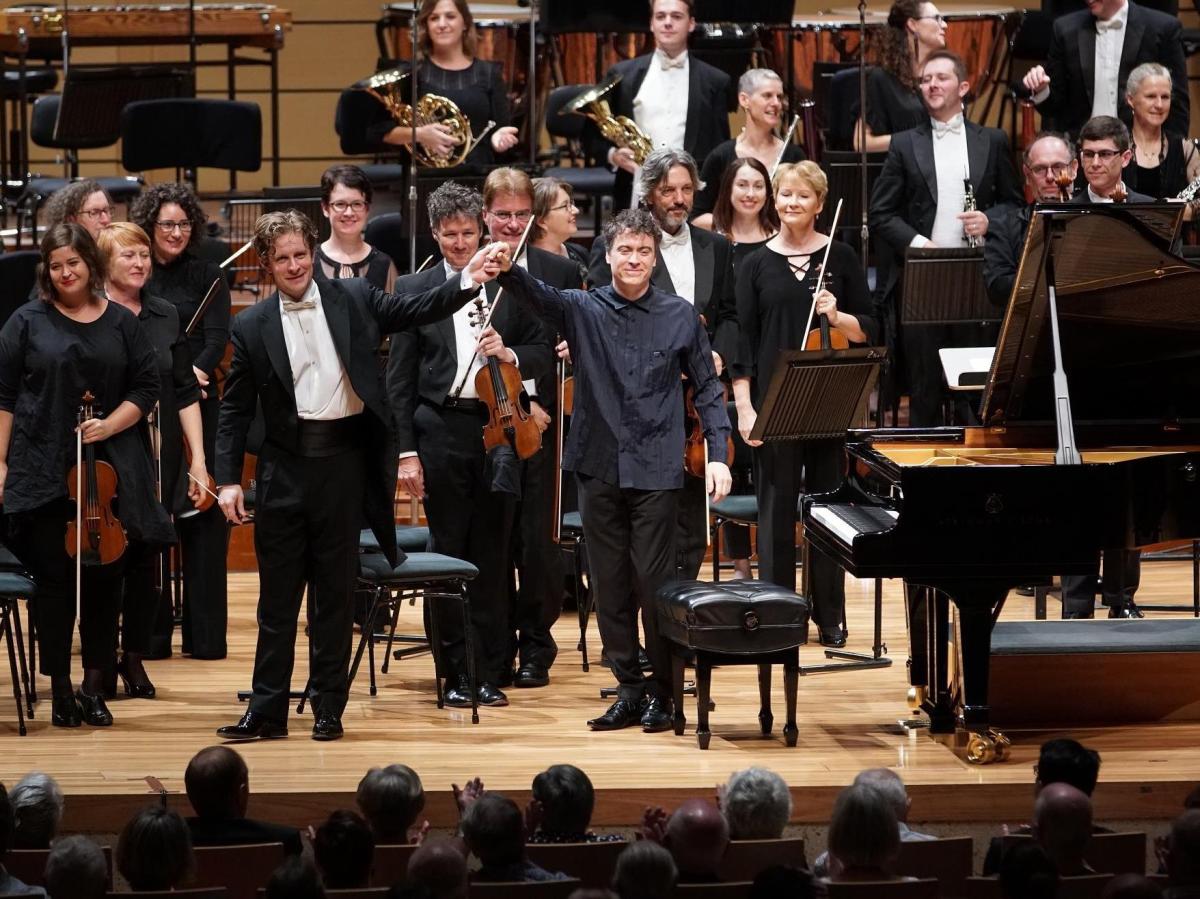Conductor Daniel Blendulf and Paul Lewis on piano with the Queensland Symphony Orchestra in Maestro Series 1: Heavenly at QPAC.
The Queensland Symphony Orchestra (QSO) opened its 2019 season with a Maestro Concert offering two exemplary works – Mozart’s final Piano Concerto No. 27, composed just months before his death, and Mahler’s spiritual Symphony No.4. In their final movements both works share an association with the world of childhood, the Mahler evoking the child’s vision of heaven.
It was disappointing that QSO’s Music Director, Alondra de la Parra, advertised as the Conductor of this opening concert of her 2019 season, became unavailable. However, her last-minute substitute Daniel Blendulf, a young Swedish conductor with an impressive list of achievements, proved to be an excellent choice. He had a confident and strong presence on the podium and conducted with authority and panache, delivering an intelligent, considered interpretation of the Mahler that brought forth the musical colours with tenderness, joy and, at times, a heart-felt profundity.
Mozart’s Piano Concerto No.27 in B flat is masterfully crafted and musically sublime. Displaying a strict adherence to the classical structure, Mozart nevertheless introduces an interplay between piano and orchestra with increased and often urgent intent over the three movements. And his melodies shine through in a lively, colourful musical palette though interspersed with reflective and introspective passages.
British pianist, Paul Lewis, this year’s Artist-in-Residence with the QSO, showed virtuosic technical proficiency with a keen and precise understanding of Mozart’s style, offering careful phrasing and a clear, precise tone. His distinct light touch on the keys produced a subtle and understated interpretation for the most part, giving us restraint rather than a depth of emotional involvement. Only in the more free-ranging cadenzas of the third movement did he feel able to let rip. Then we heard in his playing the excitement and passion burst forth, followed by the support of strings and woodwind, as the orchestra took up the theme, with some thrilling trills and arpeggios.
However, such close adherence to the classical form gave the impression that both conductor and orchestra were hard pressed to produce a greater balance of light and shade, of restraint and emotion, inherently contained within Mozart’s music. When there was an opportunity for the orchestra to increase both briskness and energy, it did so with great aplomb but, at other times, the soundscape came over as unusually flat, even luck-lustre. This was a pity as, with a less rigorous approach, the concerto would have been able to soar.
For an encore, Paul Lewis chose Schubert’s Allegretto in C minor, an emotive piece that was intensely played.
The second half of the concert offered a brilliant reading of Mahler’s 4th Symphony with some exceptionally fine playing from the orchestra, including solos from all the woodwind players – flute, oboe, clarinet, bassoon and French horns, alongside trumpet and percussion.
Maestro Blendulf set a finely-honed pace from the start with his crystal-clear interpretation of the natural world that Mahler loved so much. From the opening sleigh bells through the accompanying bird-sounds of the woodwind and the wide sweeping theme of the strings, the simplistic, childlike humour showed through musically, particularly in the first and second movements. The second movement also introduced a character from medieval German folklore, in the ‘fiddle’ of the solo violin, with its tricky passages proficiently played by concertmaster, Warwick Adeney.
In the impressive haunting third movement, ‘Ruhevoll’, with its intertwined themes of peace and tranquillity set against that of a troubling deep sadness, Blendulf conducted passionately to reveal the underlying spiritual depth of Mahler’s work. The passages of brooding darker strings, bassoon and trumpet alternating with the serenity of the flute, oboe, horns and delicate higher strings were exquisitely delivered.
Composed prior to the first three movements and based on an earlier favourite song, ‘The Heavenly Life’, Mahler added a vocal element to his final movement which is the heart and soul of the Symphony. Soprano Morgan England-Jones injected a mixture of fun, joy, and wonder into the lullaby, her full-bodied lyric having just the right luscious, sweet-sounding edge to create the necessary sense of childlike awe. It was the perfect ending to a Heavenly evening.
Rating: 4 stars ★★★★
Maestro Series 1: Heavenly
Conductor: Daniel Blendulf
Piano: Paul Lewis
Soprano: Morgan England-Jones
16 February 2019
Concert Hall, QPAC





